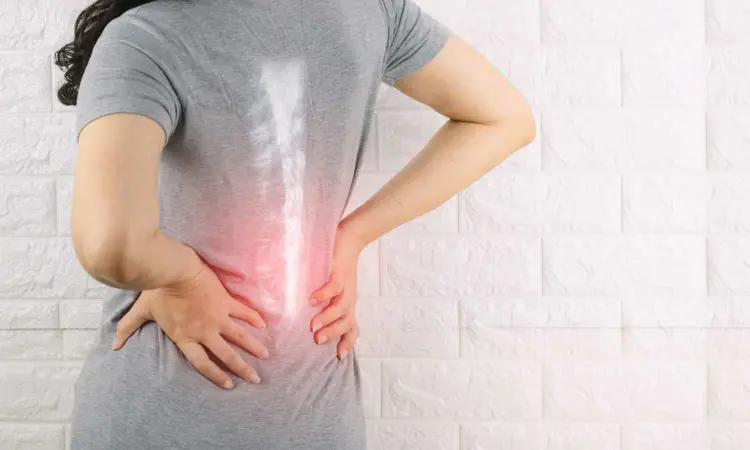- Home
- Medical news & Guidelines
- Anesthesiology
- Cardiology and CTVS
- Critical Care
- Dentistry
- Dermatology
- Diabetes and Endocrinology
- ENT
- Gastroenterology
- Medicine
- Nephrology
- Neurology
- Obstretics-Gynaecology
- Oncology
- Ophthalmology
- Orthopaedics
- Pediatrics-Neonatology
- Psychiatry
- Pulmonology
- Radiology
- Surgery
- Urology
- Laboratory Medicine
- Diet
- Nursing
- Paramedical
- Physiotherapy
- Health news
- Fact Check
- Bone Health Fact Check
- Brain Health Fact Check
- Cancer Related Fact Check
- Child Care Fact Check
- Dental and oral health fact check
- Diabetes and metabolic health fact check
- Diet and Nutrition Fact Check
- Eye and ENT Care Fact Check
- Fitness fact check
- Gut health fact check
- Heart health fact check
- Kidney health fact check
- Medical education fact check
- Men's health fact check
- Respiratory fact check
- Skin and hair care fact check
- Vaccine and Immunization fact check
- Women's health fact check
- AYUSH
- State News
- Andaman and Nicobar Islands
- Andhra Pradesh
- Arunachal Pradesh
- Assam
- Bihar
- Chandigarh
- Chattisgarh
- Dadra and Nagar Haveli
- Daman and Diu
- Delhi
- Goa
- Gujarat
- Haryana
- Himachal Pradesh
- Jammu & Kashmir
- Jharkhand
- Karnataka
- Kerala
- Ladakh
- Lakshadweep
- Madhya Pradesh
- Maharashtra
- Manipur
- Meghalaya
- Mizoram
- Nagaland
- Odisha
- Puducherry
- Punjab
- Rajasthan
- Sikkim
- Tamil Nadu
- Telangana
- Tripura
- Uttar Pradesh
- Uttrakhand
- West Bengal
- Medical Education
- Industry
Hormone therapy protects against bone loss, increases lumbar spine BMD in postmenopausal women

China: Hormone therapies increase lumbar spine BMD (bone mineral density) in postmenopausal women and protect against osteopenia, even after discontinuing the hormone preparations, says a recent study published online in the journal Menopause. However, hormone preparations were not associated with the prevalence of osteoporosis.
The findings hold importance in the current scenario, where there is a greater focus on bone health and minimizing fractures to maintain mobility as the population ages.
Osteoporosis is a common debilitating condition, with approximately 14 million cases in the United States alone. Characterized by decreased BMD and an increased risk of bone fragility that results in pain, fracture, and disability, it is often associated with estrogen deficiency. This explains why postmenopausal women have a greater risk of developing osteoporosis than older men.
Hormone therapy (HT), including estrogen-only and estrogen-progestogen combinations, is widely used for the prevention and management of osteoporosis, although there have been conflicting studies about the lingering benefits after the hormone use is discontinued.
In this study, which is based on real-world data from more than 6,000 postmenopausal women involved in the national Health and Nutrition Examination Survey, researchers sought to evaluate the associations of various types of hormone preparations with BMD, postmenopausal bone loss (osteopenia), and postmenopausal osteoporosis. They also explored the withdrawal effect of HT. Multiple therapies were studied, including oral contraceptive pills, estrogen-only pills, estrogen-progestogen combination pills, and estrogen-only patches.
On the basis of the results, researchers concluded that all the therapies evaluated increased lumbar spine BMD in postmenopausal women. Except for the estrogen-only patches, all forms of HT additionally provided protection against osteopenia. These benefits persisted even after the hormone preparations were discontinued. No association, however, was found between HT and osteoporosis prevalence.
Study results are published in the article “Association of hormone preparations with bone mineral density, osteopenia and osteoporosis in postmenopausal women: data from National Health and Nutrition Examination Survey 1999-2018.”
“This large cross-sectional study showed that current and prior use of multiple types of hormone therapies, including combined hormone contraception used in premenopausal women and menopause hormone therapies, were linked with bone protection in postmenopausal women and that these effects persisted after discontinuation of treatment. Additional study is needed to investigate the influence of time since stopping hormone therapy as well as the differential effects of various doses and formulations on bone health, including fracture risk,” says Dr. Stephanie Faubion, NAMS medical director.
Reference:
Wang Y, Sun C. Association of hormone preparations with bone mineral density, osteopenia, and osteoporosis in postmenopausal women: data from National Health and Nutrition Examination Survey 1999-2018. Menopause. 2023 May 2. doi: 10.1097/GME.0000000000002180.
Dr Kamal Kant Kohli-MBBS, DTCD- a chest specialist with more than 30 years of practice and a flair for writing clinical articles, Dr Kamal Kant Kohli joined Medical Dialogues as a Chief Editor of Medical News. Besides writing articles, as an editor, he proofreads and verifies all the medical content published on Medical Dialogues including those coming from journals, studies,medical conferences,guidelines etc. Email: drkohli@medicaldialogues.in. Contact no. 011-43720751


